巴西语言与文化英文介绍
- 格式:pptx
- 大小:196.82 KB
- 文档页数:3
![巴西介绍[最新]](https://uimg.taocdn.com/2986c7a064ce0508763231126edb6f1afe007146.webp)
巴西概况General国名:巴西联邦共和国Official Name: The Federative Republic of Brazil国旗:绿、黄色是巴西的国色。
绿色象征巴西广大的丛林,黄色象征丰富的矿藏和资源。
天球仪的白带上用葡文写着:“秩序和进步”,下半部象征南半球星空,其上下大小不同的白色五角星代表巴西的26个州和一个联邦区。
National Flag: The national flag (proportions 10 y 7) is green, bearing, at the centre, a yellow diamond containing a blue celestial globe with 26 white five-pointed stars (one for each of Brazil's states), arranged in the pattern of the southern firmament, below an equatorial scrol lwith the motto 'Ordem e Progresso' ('Order and Progress'), and a single star above the scroll.国徵:大五角星象征国家的独立和团结。
大五角星中的五颗五角星(其中一枚较小)象征南十字星座。
圆环中的22颗小五角星象征巴西各州和联邦区。
周围是咖啡叶和烟草叶,下端是一柄剑,绶带上用葡萄牙文写着“巴西联邦共和国”,“1889年11月15日”(共和国成立日)。
国歌:《听,依必郎加的呼声》。
它是由著名诗人华奎姆·奥索里奥、杜克·埃斯特拉达在1909年根据1831年国歌的曲调重新填写歌词的,1922年被定为国歌。
歌词回顾了1822年9月7日佩德罗一世在圣保罗郊外伊比朗加河畔发生“不独立,毋宁死”呼声的情景,歌词歌颂了祖国获得了独立,充满着巴西人民对祖国的爱恋之情。
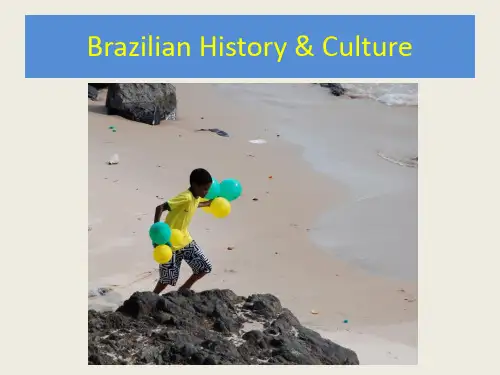

七年级巴西知识点总结随着中国与世界各国的交往日益加深,学习国际化知识变得越来越重要。
作为一个新兴的经济大国,学习巴西的语言、文化和历史知识就显得特别必要。
本文将总结七年级巴西教材中常见的语言、文化和历史知识点,以帮助学生更好地学习和了解巴西。
一、语言1.巴西默认语言:葡萄牙语2.基础词汇:- Olá:你好- Adeus:再见- Bom dia:早上好- Boa tarde:下午好- Boa noite:晚上好- Por favor:请- Obrigado(a):谢谢- Desculpe:对不起- Sim:是- Não:否- Eu:我- Você:你3.语法:- 葡萄牙语中的动词变化规则比较复杂,常见的有现在时和过去时等。
- 名词分男女性,有单复数之分。
形容词需要与名词性别和单复数相同。
- 问句需要在句子前面加上疑问词,例如“Onde você mora?”(你住在哪里?)二、文化1.食物文化:- 巴西菜肴中常见的有:粉状炖肉(feijoda)、烤肉(churrasco)、塔玛豆腐(tapioca)等。
- 巴西也是咖啡产地,咖啡是巴西人最喜欢的饮品之一。
2.音乐文化:- 轻快节奏的巴西桑巴舞曲在世界范围内非常有名。
- 巴西还有着丰富的传统音乐文化,例如在河流村庄中流行的弹唱风格巴赞托音乐(bossa nova)。
3.体育文化:- 巴西著名的体育项目是足球,巴西国家队在国际足球比赛中大获成功,并培养出不少世界级球星。
三、历史1.巴西历史概述:- 巴西是一个由多种族和文化组成的国家,曾经被葡萄牙殖民,于1822年独立建国。
- 巴西的经济模式曾从农业、矿业向工业转型,最近又开始发展高科技产业。
2.近代史:- 巴西在20世纪70年代末至80年代初的军政府时期,发生了政治迫害和经济萎缩等社会问题。
- 1990年代以后,民主政治渐渐确立,社会发展逐渐稳步增长。
总结:通过本文对巴西语言、文化和历史知识点的总结,希望能够帮助七年级学生更好地学习和了解巴西。

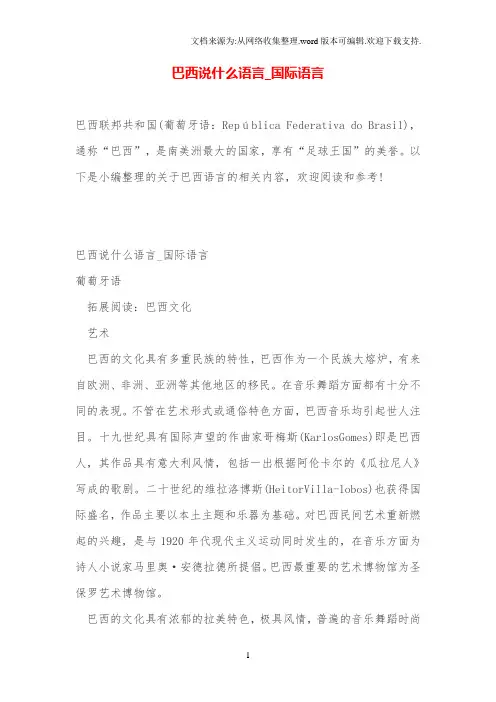
巴西说什么语言_国际语言巴西联邦共和国(葡萄牙语:República Federativa do Brasil),通称“巴西”,是南美洲最大的国家,享有“足球王国”的美誉。
以下是小编整理的关于巴西语言的相关内容,欢迎阅读和参考!巴西说什么语言_国际语言葡萄牙语拓展阅读:巴西文化艺术巴西的文化具有多重民族的特性,巴西作为一个民族大熔炉,有来自欧洲、非洲、亚洲等其他地区的移民。
在音乐舞蹈方面都有十分不同的表现。
不管在艺术形式或通俗特色方面,巴西音乐均引起世人注目。
十九世纪具有国际声望的作曲家哥梅斯(KarlosGomes)即是巴西人,其作品具有意大利风情,包括一出根据阿伦卡尔的《瓜拉尼人》写成的歌剧。
二十世纪的维拉洛博斯(HeitorVilla-lobos)也获得国际盛名,作品主要以本土主题和乐器为基础。
对巴西民间艺术重新燃起的兴趣,是与1920年代现代主义运动同时发生的,在音乐方面为诗人小说家马里奥·安德拉德所提倡。
巴西最重要的艺术博物馆为圣保罗艺术博物馆。
巴西的文化具有浓郁的拉美特色,极具风情,普遍的音乐舞蹈时尚(如:桑巴舞)多来自民间,主要受非裔所影响深远。
也是由未接受正式音乐训练的人演奏。
每年二月,嘉年华会时蜂拥而出的新歌曲,有许多题材是当时的社会环境或是周遭发生的事情,透过个人演出表现多姿多彩的嘉年华会,正是巴西多重文化的表现方式之一。
教育巴西教育体系分基础教育和高等教育两级,基础教育又分初级教育和中等教育。
初级教育相当于中国的小学和初中,中等教育相当于中国的高中。
高等教育指各类大学,学制一般为四年。
据巴西教育部统计,各类学校20.7万所,其中联邦学校208所,州立学校3.37万所,市立学校13.78万所,私立学校3.55万所。
初级学校在校学生约3353万,中等教育学校在校学生约903.2万,职业教育学校在校生约70.56万。
巴西共有高等教育机构1859所,其中大学163所,在校生共计388.8万。
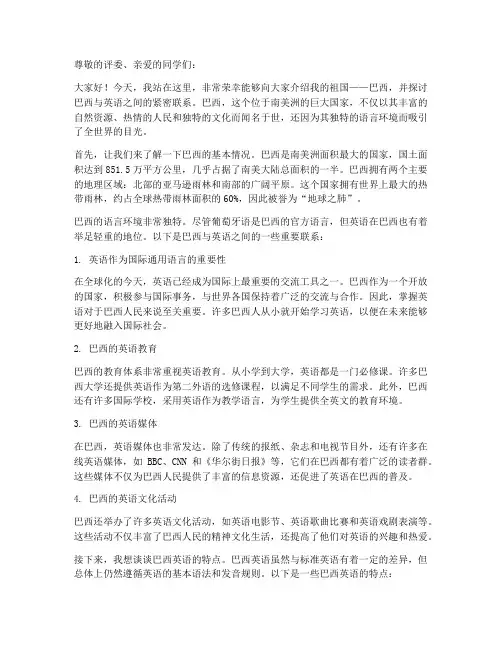
尊敬的评委、亲爱的同学们:大家好!今天,我站在这里,非常荣幸能够向大家介绍我的祖国——巴西,并探讨巴西与英语之间的紧密联系。
巴西,这个位于南美洲的巨大国家,不仅以其丰富的自然资源、热情的人民和独特的文化而闻名于世,还因为其独特的语言环境而吸引了全世界的目光。
首先,让我们来了解一下巴西的基本情况。
巴西是南美洲面积最大的国家,国土面积达到851.5万平方公里,几乎占据了南美大陆总面积的一半。
巴西拥有两个主要的地理区域:北部的亚马逊雨林和南部的广阔平原。
这个国家拥有世界上最大的热带雨林,约占全球热带雨林面积的60%,因此被誉为“地球之肺”。
巴西的语言环境非常独特。
尽管葡萄牙语是巴西的官方语言,但英语在巴西也有着举足轻重的地位。
以下是巴西与英语之间的一些重要联系:1. 英语作为国际通用语言的重要性在全球化的今天,英语已经成为国际上最重要的交流工具之一。
巴西作为一个开放的国家,积极参与国际事务,与世界各国保持着广泛的交流与合作。
因此,掌握英语对于巴西人民来说至关重要。
许多巴西人从小就开始学习英语,以便在未来能够更好地融入国际社会。
2. 巴西的英语教育巴西的教育体系非常重视英语教育。
从小学到大学,英语都是一门必修课。
许多巴西大学还提供英语作为第二外语的选修课程,以满足不同学生的需求。
此外,巴西还有许多国际学校,采用英语作为教学语言,为学生提供全英文的教育环境。
3. 巴西的英语媒体在巴西,英语媒体也非常发达。
除了传统的报纸、杂志和电视节目外,还有许多在线英语媒体,如BBC、CNN和《华尔街日报》等,它们在巴西都有着广泛的读者群。
这些媒体不仅为巴西人民提供了丰富的信息资源,还促进了英语在巴西的普及。
4. 巴西的英语文化活动巴西还举办了许多英语文化活动,如英语电影节、英语歌曲比赛和英语戏剧表演等。
这些活动不仅丰富了巴西人民的精神文化生活,还提高了他们对英语的兴趣和热爱。
接下来,我想谈谈巴西英语的特点。
巴西英语虽然与标准英语有着一定的差异,但总体上仍然遵循英语的基本语法和发音规则。
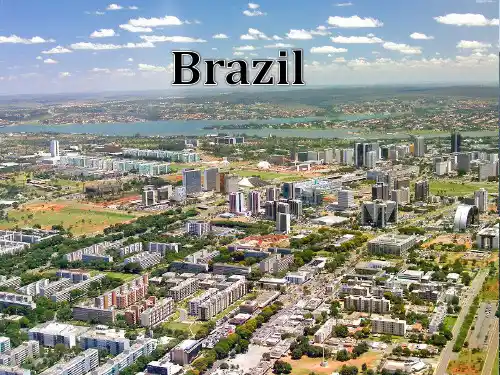
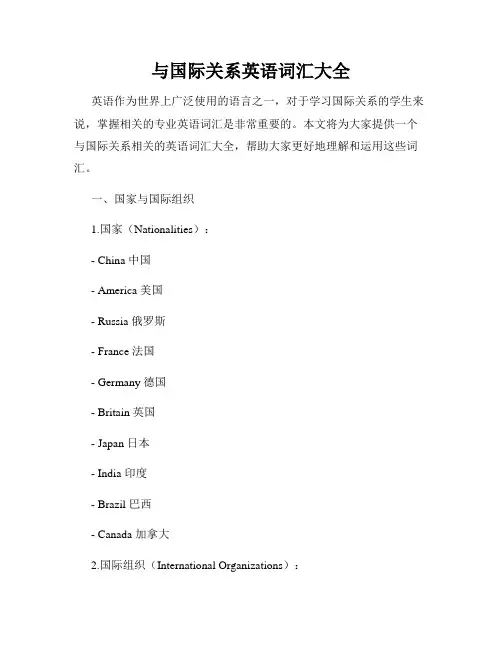
与国际关系英语词汇大全英语作为世界上广泛使用的语言之一,对于学习国际关系的学生来说,掌握相关的专业英语词汇是非常重要的。
本文将为大家提供一个与国际关系相关的英语词汇大全,帮助大家更好地理解和运用这些词汇。
一、国家与国际组织1.国家(Nationalities):- China 中国- America 美国- Russia 俄罗斯- France 法国- Germany 德国- Britain 英国- Japan 日本- India 印度- Brazil 巴西- Canada 加拿大2.国际组织(International Organizations):- United Nations 联合国- World Trade Organization 世界贸易组织- International Monetary Fund 国际货币基金组织- European Union 欧盟- NATO 北大西洋公约组织- World Bank 世界银行- International Atomic Energy Agency 国际原子能机构- World Health Organization 世界卫生组织- International Criminal Court 国际刑事法院- Organization of Petroleum Exporting Countries 石油输出国组织二、政治与外交1.政治制度(Political Systems):- Democracy 民主- Republic 共和国- Monarchy 君主制- Socialism 社会主义- Capitalism 资本主义- Communism 共产主义- Totalitarianism 极权主义- Autocracy 独裁统治- Federation 联邦制- Confederation 联盟制2.外交与外交政策(Diplomacy and Foreign Policy):- Diplomat 外交官- Diplomatic Mission 外交使团- Embassy 大使馆- Consulate 领事馆- Ambassador 大使- Diplomatic Immunity 外交豁免权- Bilateral Relations 双边关系- Multilateral Relations 多边关系- Diplomatic Negotiation 外交谈判- Peacekeeping 和平维持三、国际法与国际组织1.国际法(International Law):- Sovereignty 主权- Territory 领土- Treaty 条约- Diplomatic Recognition 外交承认- International Court of Justice 国际法院- Geneva Conventions 日内瓦公约- United Nations Convention Against Torture 联合国禁止酷刑公约- International Criminal Court 国际刑事法院2.国际组织(International Organizations):- United Nations 联合国- World Trade Organization 世界贸易组织- International Monetary Fund 国际货币基金组织- European Union 欧盟- NATO 北大西洋公约组织- World Bank 世界银行- International Atomic Energy Agency 国际原子能机构- World Health Organization 世界卫生组织- International Criminal Court 国际刑事法院- Organization of Petroleum Exporting Countries 石油输出国组织四、国际经济与贸易1.国际贸易(International Trade):- Import 进口- Export 出口- Tariff 关税- Free Trade 自由贸易- Protectionism 保护主义- Trade Deficit 贸易逆差- Trade Surplus 贸易顺差- Balance of Payments 收支平衡- World Trade Organization 世界贸易组织- Trade Agreement 贸易协定2.国际金融(International Finance):- Exchange Rate 汇率- Currency 货币- Foreign Direct Investment 外商直接投资- International Monetary Fund 国际货币基金组织- World Bank 世界银行- International Financial Crisis 国际金融危机- Inflation 通货膨胀- Recession 经济衰退- Economic Development 经济发展- Sustainable Development 可持续发展五、战争与安全1.军事和战争(Military and War):- Armed Forces 武装力量- Army 陆军- Navy 海军- Air Force 空军- War 战争- Conflict 冲突- Defense 防御- Nuclear Weapons 核武器- Peace 和平- Terrorism 恐怖主义2.安全与安全合作(Security and Security Cooperation):- National Security 国家安全- Collective Security 集体安全- Arms Control 军备控制- Non-proliferation 非扩散- Peacekeeping 和平维持- Security Council 安全理事会- Security Alliance 安全联盟- Intelligence Intelligence 情报六、跨文化交流与全球化1.语言与文化(Language and Culture):- Language 语言- Culture 文化- Interpreter 翻译- Cultural Exchange 文化交流- Cultural Diversity 文化多样性- Intercultural Communication 跨文化交际- Globalization 全球化- Cultural Imperialism 文化帝国主义- Cultural Relativism 文化相对主义- Cultural Assimilation 文化同化2.国际媒体与科技(International Media and Technology):- Internet 互联网- Social Media 社交媒体- Mass Media 大众媒体- Communication Communication 通信- Information Information 信息- Digitalization 数字化- Cybersecurity 网络安全- Artificial Intelligence 人工智能- Virtual Reality 虚拟现实- E-commerce 电子商务这份国际关系英语词汇大全涵盖了与国际关系相关的各个方面,希望能够对大家的学习和研究有所帮助。

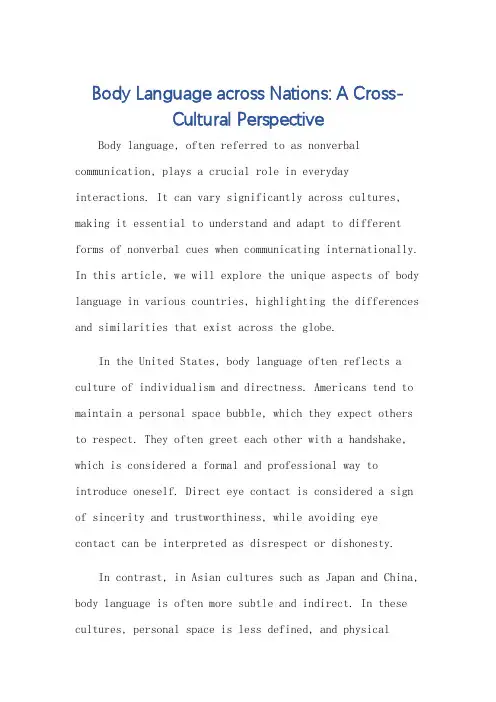
Body Language across Nations: A Cross-Cultural PerspectiveBody language, often referred to as nonverbal communication, plays a crucial role in everyday interactions. It can vary significantly across cultures, making it essential to understand and adapt to different forms of nonverbal cues when communicating internationally. In this article, we will explore the unique aspects of body language in various countries, highlighting the differences and similarities that exist across the globe.In the United States, body language often reflects a culture of individualism and directness. Americans tend to maintain a personal space bubble, which they expect others to respect. They often greet each other with a handshake, which is considered a formal and professional way to introduce oneself. Direct eye contact is considered a sign of sincerity and trustworthiness, while avoiding eye contact can be interpreted as disrespect or dishonesty.In contrast, in Asian cultures such as Japan and China, body language is often more subtle and indirect. In these cultures, personal space is less defined, and physicalcontact, such as bowing or touching the forearm, is common when greeting someone. Eye contact is often made brieflyand then averted to avoid appearing too direct or intrusive. In Latin American countries like Brazil and Argentina, body language is often more expressive and gestural. People tend to speak with their hands, using expansive gestures to emphasize points. Touching, hugging, and kissing on the cheek are common forms of greeting among friends and family. Direct eye contact is considered respectful, andmaintaining eye contact during a conversation is essential. In the Middle East, particularly in countries likeSaudi Arabia and Iran, body language is deeply influencedby Islamic culture. People often greet each other with a handshake and a nod of the head. However, physical contact, especially between men and women who are not related, is strictly avoided. Eye contact, especially between men and women, can be considered inappropriate in some contexts.It's important to note that while these generalizations provide a basic understanding of body language across cultures, there are always exceptions and variations within each culture. Additionally, body language can be influencedby individual personality traits, social context, and personal comfort levels.When communicating internationally, it's crucial to be aware of these cultural differences and to adapt your body language accordingly. Observing and understanding the nonverbal cues of the culture you are in can help you convey respect, build trust, and establish stronger relationships. By being mindful of your own body language and adapting to the norms of the culture you are engaging with, you can ensure more effective and enjoyable communication experiences.**肢体语言跨越国界:跨文化视角**肢体语言,通常被称为非言语交流,在日常交往中发挥着至关重要的作用。

巴西说什么语言_国际语言巴西联邦共和国(葡萄牙语:República Federativa do Brasil),通称“巴西”,是南美洲最大的国家,享有“足球王国”的美誉。
以下是小编整理的关于巴西语言的相关内容,欢迎阅读和参考!巴西说什么语言_国际语言葡萄牙语拓展阅读:巴西文化艺术巴西的文化具有多重民族的特性,巴西作为一个民族大熔炉,有来自欧洲、非洲、亚洲等其他地区的移民。
在音乐舞蹈方面都有十分不同的表现。
不管在艺术形式或通俗特色方面,巴西音乐均引起世人注目。
十九世纪具有国际声望的作曲家哥梅斯(KarlosGomes)即是巴西人,其作品具有意大利风情,包括一出根据阿伦卡尔的《瓜拉尼人》写成的歌剧。
二十世纪的维拉洛博斯(HeitorVilla-lobos)也获得国际盛名,作品主要以本土主题和乐器为基础。
对巴西民间艺术重新燃起的兴趣,是与1920年代现代主义运动同时发生的,在音乐方面为诗人小说家马里奥·安德拉德所提倡。
巴西最重要的艺术博物馆为圣保罗艺术博物馆。
巴西的文化具有浓郁的拉美特色,极具风情,普遍的音乐舞蹈时尚(如:桑巴舞)多来自民间,主要受非裔所影响深远。
也是由未接受正式音乐训练的人演奏。
每年二月,嘉年华会时蜂拥而出的新歌曲,有许多题材是当时的社会环境或是周遭发生的事情,透过个人演出表现多姿多彩的嘉年华会,正是巴西多重文化的表现方式之一。
教育巴西教育体系分基础教育和高等教育两级,基础教育又分初级教育和中等教育。
初级教育相当于中国的小学和初中,中等教育相当于中国的高中。
高等教育指各类大学,学制一般为四年。
据巴西教育部统计,各类学校20.7万所,其中联邦学校208所,州立学校3.37万所,市立学校13.78万所,私立学校3.55万所。
初级学校在校学生约3353万,中等教育学校在校学生约903.2万,职业教育学校在校生约70.56万。
巴西共有高等教育机构1859所,其中大学163所,在校生共计388.8万。
Today,the country we will introduce to you is Brazil.1.王彦凯One of the most famous symbols of Brazilian culture is football.The favorite pastime 消遣、娱乐of youngsters 年轻人 is playing football on streets. And over 10,000 Brazilians play for the professional football league 联盟、联赛.The Brazilian national football team is one of the most successful national football teams in the history of the World Cup, with five championships (1958, 1962, 1970, 1994, 2002).2.冯硕Samba!The Samba dance originated起源from Africa.It is full of passion and vitality活力.Besides,the Samba dance is quite 相当beautiful and the music has a strong rhythm节奏.3.苑菁The 105-foot-tall (38-meter-tall) Christ the Redeemer耶稣基督像statue in Rio de Janeiro, Brazil, is one of the “new seven wonders of the world”.It started to be built in 1921 and finished in 1931.The statue is so spectacular壮观的that it attracts thousands of tourists to pay a visit to it every day.4.何知远Iguassu Falls are the waterfalls瀑布 of the Iguassu River located on the border边界 of the Brazilian state of Paraná巴拉那and the Argentine 阿根廷的province of Misiones米西奥内斯.在......之内、坐落于......be located in =lie in表接壤的关系be located on 中国和蒙古的地理位置关系在一个具体地方be located at表不接壤的、相对的关系be located to 中国和日本的地理位置关系5.徐畅Coffee has been one of the main beverages 饮料among Brazilians since the beginning of the 19th century.Brazilians are fond of drinking strong coffee comparatively相当地.After waking up in the morning,the first thing they will do is to drink a cup of coffee.6.孙羽霆The annual年度的 Carnival in Brazil is a unique festival节日. It is also the most important ethnic种族的 celebration庆祝.It comes between the end of February and the beginning of March every year.Thousands of tourists from overseas海外are attracted to join the feast宴会 of rejoicing 庆祝.。